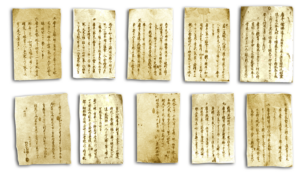
Ten Precepts of Karate
In October 1908, Anko Itosu (1831-1915) wrote a letter, “Ten Precepts of Karate,” to draw the attention of the Ministry of Education and the Ministry of War in Japan. This document is probably one of the most important historical texts written ever. This letter was contributing, perhaps decisive, to make Karate widely known.
Most of the text lends itself. I will therefore leave the interpretation of Itosu’s text up to you, although I have attached small short comments.
I would encourage you to search similar texts elsewhere to compare them, it allows you to form your impression and interpretation of the text.
Ten Precepts (Articles) of Karate
Karate is not something that came from Buddhism. Long ago two schools, Shorin-Ryu and Shorei-Ryu, were introduced from China, and both factions have their characteristics and strengths.
It is necessary to preserve them as they are and not modify them. In the following, I will list my point of view.
Comment: Itosu makes it very clear from the beginning; that there is no connection between Karate and religion. He also states, that there were two variations of Karate, Shorin and Shorei, both from China.
One
Karate is not for physical (health) training only, it can also be used for the protection of the country, family, and one’s master, even if it means risking your life. However, Karate is not meant to be used against a single assailant. Therefore, in the case, you are attacked by a random assailant, see if it is possible to avoid a fight and to manage the situation peacefully. Never think of harming another person by your punches or kicks.
Comment: An important point is Itosu’s description of the use of Karate. Karate was not intended for use against other Karateka but for self-protection against an assailant.
Two
Karate is dedicated to strengthening the muscles and making the body hard as a rock, so your limbs can be used as a spear.
By implementing Karate in elementary schools, it is possible to help the military society in the future. It can be said that today’s victory can be won at the playgrounds of each school in Japan.
Comment: Itosu draws a parallel reminiscent of the Duke of Wellington’s famous quote: “The battle of Waterloo was won on the playing fields of Eton.” This quote is often attributed to the Duke, an Eton College graduate and the commander in chief of the British and allied armies at Waterloo.
Three
Karate is difficult to master rapidly. There is a saying, that even if the bull moves slowly, in the end, it will eventually travel one thousand Ri.
If you practice for three or four years for an hour or two every day, you will eventually see a transformation of your body. Those who train in this manner will discover the deeper principles of Karate.
Comment: Ri (里) Old Japanese unit of distance, approx. 3.927km or 2.44 miles.
Four
The use of Makiwara is important for the development of the fists and legs. I advise that you keep your shoulders low (relaxed), open your lungs, take a strong stance, and sink your energy into your Tanden before executing the technique. Hit the Makiwara about 100-200 times with each hand and foot.
Comment: Tanden refers to the center of the body. It is three finger widths below the navel and two finger widths inward.
Five
When practicing Karate stances, make sure to keep your back straight, lower your shoulders (relax), and make sure you have a solid grip on the floor. Focus your energy on the Tanden.
